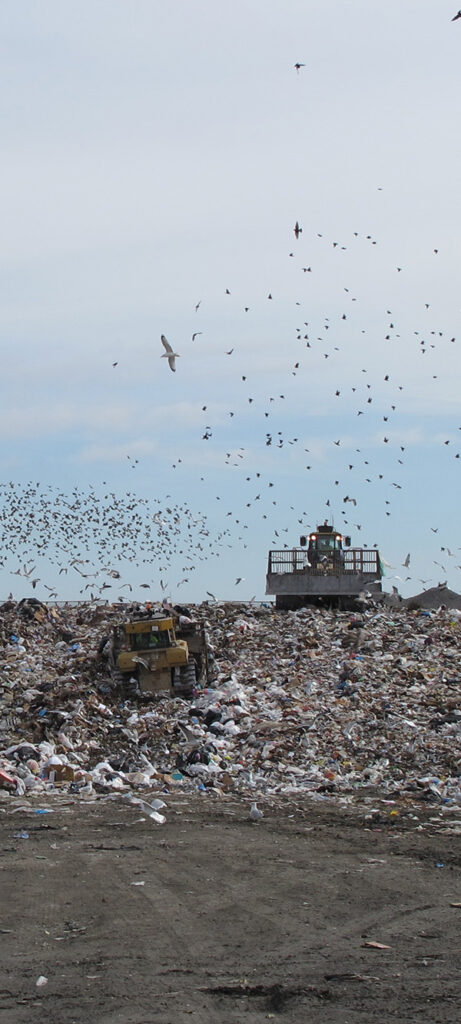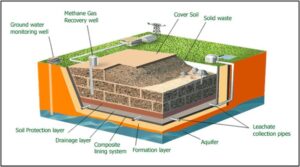solid waste 101

Landfills
Landfills are the least desirable way to dispose of municipal solid waste. They are basically tracts of land dedicated to the disposal and burial of trash. Their predecessors were open dumps, typically one in each town, where trash was burned periodically to reduce volume. These sites leached toxic liquids into nearby water bodies, as many dumps were located in or at the edge of wetlands or streams, and the burning generated air pollution. The Resource Conservation and Recovery Act of 1976 (Public Law 94-580) mandated the end of open dumping by 1983, which led to establishment of municipal transfer stations and large, centralized landfills that accept waste from wide geographic areas.
The modern landfill is a sophisticated version of the old-fashioned dump. Impermeable liners contain the trash and leachate within a confined space, trash is compacted after dumping to reduce volume, and each day’s deposits are covered with soil. Practically speaking, landfills are now designed to protect the environment from contaminants in the waste stream. They can no longer be built in environmentally sensitive areas and require onsite monitoring systems to protect against groundwater contamination and gas emissions into the atmosphere. Landfills must now meet specific design, operation and closure standards. These practices help reduce odor; control litter, insects, and rodents; and protect public health.
The Environmental Protection Agency maintains nationwide minimum standards for landfill construction, maintenance, and closure, and authorizes states to enact standards more stringent than the minimums.
States have the authority to:
- issue permits for landfills;
- ensure that landfills are constructed sufficiently distant from wetlands, flood plains, housing developments, and other restricted areas;
- regulate the integrity of flexible and impermeable liners on the bottom and sides of landfills to prevent leachate from contaminating soil and water sources; and
- regulate the collection of leachates for treatment and disposal.
When a new landfill is constructed, the bottom of the site must first be lined with clay. Above this comes a blanket of flexible plastic followed by a layer of porous material, such as coarse sand, to provide drainage for leachate that percolates down through the solid waste. Leachate is a toxic mixture of rainwater and liquefied garbage that contains metals and other hazardous chemicals. A drainage system above the impermeable liner collects this liquid so it can be removed and treated to remove the contaminants. Monitoring wells downslope from the landfill are maintained to detect any escaping leachate.
Once permitted, a landfill can begin receiving trash, which is typically delivered by garbage trucks. Machines compress these deliveries into a tightly packed mound and each day’s additions are covered with a layer of soil. A final layer of clay and thin plastic cap the landfill once a landfill reaches its maximum capacity. Then it is covered with several feet of soil so that plants can grow on top.

Some landfills, called “dry tomb landfills,” are designed to minimize the amount of liquid within the landfill. Waste decomposes very slowly in these facilities and production of landfill gases is minimized.
Other landfills, called “bioreactors,” are managed specifically to produce landfill gas, primarily methane, which is collected and burned to generate electricity. Collected leachate and additional water is circulated through the waste layers, which speeds decomposition and production of gas.
Despite being the least desirable form of waste management, they still receive the greatest percentage of solid waste. The Environmental Protection Agency estimates that 146.1 million tons of solid waste was landfilled in 2018, representing 50% of waste generated, compared to 69.1 million tons (24%) recycled, 34.6 million tons (12%) incinerated with energy recovered, 24.9 million tons (8%) composted, and 17.7 million tons (6%) managed in other ways.
Landfills are somewhat of a necessary evil and will always play a role in the management of solid waste. However, their role can and must be substantially reduced in the coming years.
Resources
EPA Links:
- Landfills
- National Overview: Facts and Figures on Materials, Wastes and Recycling
- History of the Resource Conservation and Recovery Act (RCRA)
- New Law to Control Hazardous Wastes, End Open Dumping, Promote Conservation of Resources (1976)
Original source document for landfill cross-section image
Stay in Touch
Join our email list to stay on top of the latest news on sustainable solid waste management, including action alerts for ways you can make your voice heard!
